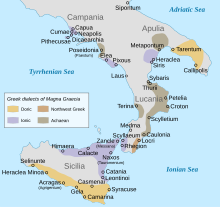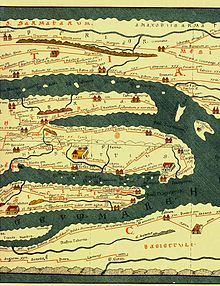History of Taranto
Taras gradually increased its influence, becoming a commercial power and a city-state of Magna Graecia and ruling over many of the Greek colonies in southern Italy.[1][2] According to the legend Phalanthus, the Parthenian leader, went to Delphi to consult the oracle and received the puzzling answer that he should found a city where rain fell from a clear sky.In 466 BC, Taranto was again defeated by the Iapygians; according to Aristotle,[5] who praises its government, there were so many aristocrats killed that the democratic party was able to get the power, to remove the monarchy, inaugurate a democracy, and expel the Pythagoreans.Though the city’s hoplite infantry and cavalry continued to enjoy a notable reputation, its restrictive policies of citizenship meant that Taras could not match the numbers of first the Apulian tribes, then the Samnites, and finally the Romans.At the beginning of the 3rd century BC Rome's increasing power started to frighten Taranto, especially in terms of mastery of the sea and control over the Greek colonies in Magna Graecia.In 282 BC, Rome sent a fleet under Admiral Lucius Valerius, carrying troops to garrison Thurii, but ten ships were caught in a tempest and arrived in the sea off Taranto during a holy day (the festival of Dionysus).Rome sent diplomats to Taranto, but the talks were broken off by the Tarentines: the Roman ambassador, Postumius, was insulted and mocked by Philonides, a member of the popular party.He had 20,000 infantry (pikemen from Epirus and Macedonia, mercenary hoplites from around Greece, and peltasts), 500 slingers, 2,000 archers, 3,000 elite cavalry from Thessaly, and 20 war elephants.The war against Rome revamped, but this time Pyrrhus was matched by the Romans in the Battle of Beneventum (275 BC) and elected to give up his Italian campaign as Antigonus II of Macedon would not send him reinforcements.However, a group of Tarentine hostages held in Rome were caught trying to escape and thrown from the Tarpeian Rock as traitors; probably because of this, anti-Roman feeling in the city increased greatly.Tarentum had a municipal law, Lex municipii Tarenti; a partial copy inscribed on bronze plates was discovered in 1894 by Luigi Viola [it], and is now at the Museo Archeologico Nazionale of Naples.During the late Republic and all the Roman Empire, Taranto was a simple provincial city (Prefecture of Italy, Diocese of Italia suburbicaria, Apulia et Calabria province).In 880, two Byzantine armies, led by generals Prokopios and Leo Apostyppes, and a fleet commanded by the admiral Nasar, took Taranto from the Arabs, ending a forty years dominion.Among the first actions taken by Apostyppes was the enslavement and deportation of the Latin-Longobard original inhabitants and the import of Greek colonists, in order to increase the population.[citation needed] The Byzantine emperor Nicephorus II Phocas understood the importance of a strong military presence and harbour in southern Italy, and rebuilt the city.He added several military fortifications, and made Taranto a stronghold of Roman resistance against the uprising Norman power in south Italy.After three years, in 1063, the Norman count Geoffrey, son of Petron I, entered in Taranto, but he was obliged to flee from it on the arrival of the Byzantine admiral Michael Maurikas.The principality of Taranto, during its 377 years of history, was sometimes a powerful and almost independent feudal fief of the Kingdom of Sicily (and later of Naples), sometimes only a title, often given to the heir to the crown or to the husband of a reigning queen.In March 1502, the Spanish fleet of king Ferdinand II of Aragon, allied to Louis XII of France, seized the port and conquered Taranto.After the defeat of Ferdinand IV of Naples at Monteregio and the subsequent Peace of Florence, in 1801 the French general Jean-de-dieu Soult occupied with 13,000 soldiers the provinces of Bari, Lecce and the harbour of Taranto.On 23 April 1801, 6,000 French soldiers of the Armée d'observation du midi entered in Taranto (20.000 inhabitants at the time) and fortified it in order to obtain "a sort of Gibitrair" (Napoleon).On March 30, 1806, Bonaparte's decree created Tarente (the French name for the city) one of six hereditary duchés grand-fiefs in the satellite kingdom of Naples, awarded to maréchal MacDonald in 1809 (line extinguished 1912).With the fall of Napoleon and the defeat of Joachim Murat at the battle of Tolentino, Southern Italy and Taranto returned under the Bourbon dynasty's rule, forming the Kingdom of the Two Sicilies.On 21 June, one day too late to allow Admiral Carlo di Persano to receive Tarentine honorary citizenship, the fleet left for the Adriatic Sea.After the defeat of the Italian fleet at Lissa, Persano was put under trial for incompetence and cowardice, and his easy days in Taranto was indicated as part of his bad behaviour.





TarantoMagna GraeciaGreek coloniesSpartaPartheniaeperioeciFirst Messenian WarPhalanthusDelphioraclePoseidonHeraclesRhegionIapygianMessapiansPeucetiansLucaniansIapygian-Tarentine WarsKailiaAristotlePythagoreansPeloponnesian WarThuriiHeracleaCarthageEtruscansArchytasArchidamus IIIManduriaEpiroticAlexander MolossusBruttiiSamnitesBattle of PandosiaCosenzaAgathoclesSyracuseSicilyCalabriaCleonymus of SpartaApuliaLucaniaCrotondemocratsaristocratsGulf of TarantoDionysusPyrrhic WarPyrrhus of EpirusLucius Aemilius BarbulaCineasCorcyraIllyrian tribesMacedonphalanxesSyrianAntigonus II GonatasEgyptianwar elephantsThessalylegionnairesBattle of HeracleaBattle of AsculumFoggiaBattle of Beneventum (275 BC)Second Punic WarHannibalTarpeian RockBruttianTabula PeutingerianaCliniasZeuxisGaius Sempronius GracchusNeptunemunicipiumMarcus AntoniusOctavianusLepidussecond triumvirateNaplesRepublicRoman EmpireApulia et CalabriaTrajanusVisigothicOstrogothicGothic warsByzantine EmpireLombardsConstans IIPope VitalianBrindisiBerbersBeneventoTheophilusAdriatic SeaCampaniaAbruzziPrincipality of SalernoBasil ILeo ApostyppesLongobardiaRadelchisFatimidSabir al-FataNicephorus II PhocasOtto IIBattle of StiloNormansBariotRobert GuiscardGeoffreyPrincipality of TarantoBohemond of TarantoRoger BorsaSikelgaitaKingdom of SicilyFerdinand I of NaplesKingdom of NaplesAlfonso II of NaplesFerdinand II of AragonLouis XII of FranceFerdinand IIIConsalvo de CordobaGiovanni Andrea DoriaMiguel de Cervantes